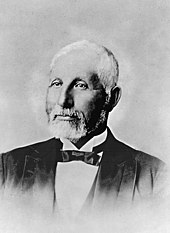
Castro Cove is a "portion of the San Pablo Bay" [1] in Richmond, California located between Point San Pablo and the confluence of Wildcat Creek into Castro Creek. [2]

Castro Cove is a "portion of the San Pablo Bay" [1] in Richmond, California located between Point San Pablo and the confluence of Wildcat Creek into Castro Creek. [2]
The cove is made up of mudflats, bay mud, and intertidal salt marsh owned by Chevron USA. The cove forms an important estuarine environmental resource for San Francisco Bay. [2] It is the home of many endangered species including the Salt Marsh Harvest Mouse, Ridgway's rail, steelhead, and Olympia Oyster. [3] Other benthic invertebrates, mammals, fish, and birds also live in the habitat; all the animals may have been injured by contamination, whether endangered or of least concern. [3] Castro Cove is named after Don Víctor Castro.[ citation needed ]
The cove is also a recreational, fishing, boating, and shellfishing area. [2] The Richmond Rod & Gun Club Yacht Harbor is located on the western coast of the cove. The Chevron Richmond Refinery located at the south end of the inlet dumps 5.6 million gallons daily of treated industrial use waters into the Cove, Castro Creek and San Pablo Bay. [2] From 1902 until 1987 the refinery released various contaminants in its wastewater and other run-off, which severely contaminated the Bay mud of the cove. [3] In 1998 the California Regional Water Quality Control Board began to plan cleanup of the site and pressured Chevron. The water board used the authority of the Bay Protection and Toxic Clean-up Program to require Chevron to produce a sediment characterization work plan in 1998. [3] Years of discharge or polluted water left the cove with high levels of polycyclic aromatic hydrocarbons (PAHs) and mercury contamination. [3]
This article needs to be updated.(August 2018) |
Between 1999 and 2001 benthic toxicity tests found PAHs and mercury levels at up to 507 mg/kg and 13 mg/kg respectively at this site and a 20-acre (81,000 m2) portion was designated as an area of concern (AOC). [3] The most contaminated, AOC is adjacent to the former wastewater outfall which has been relocated into San Pablo Bay. [3] A California Environmental Quality Act (CEQA)-mandated mitigated negative declaration was completed and a corrective action plan was designed. [3] The plan which includes a natural resource damage assessment will cordon off the AOC with steel sheet piling and have the contaminated muds and sediment dredged and pumped into a disused treatment pond. [3] In that treatment pond the toxic waste will be dried and then neutralized with a stabilizing agent like fly ash or cement. [3] The inactive pond will then be regraded and capped with vegetation. [3] The remediation project is scheduled for the summer of 2007. [3]

Polychlorinated biphenyls (PCBs) are highly carcinogenic chemical compounds, formerly used in industrial and consumer products, whose production was banned in the United States by the Toxic Substances Control Act in 1979 and internationally by the Stockholm Convention on Persistent Organic Pollutants in 2001. They are organic chlorine compounds with the formula C12H10−xClx; they were once widely used in the manufacture of carbonless copy paper, as heat transfer fluids, and as dielectric and coolant fluids for electrical equipment.

Environmental remediation deals with the removal of pollution or contaminants from environmental media such as soil, groundwater, sediment, or surface water. Remedial action is generally subject to an array of regulatory requirements, and may also be based on assessments of human health and ecological risks where no legislative standards exist, or where standards are advisory.

The Parramatta River is an intermediate tide-dominated, drowned valley estuary located in Sydney, New South Wales, Australia. With an average depth of 5.1 metres (17 ft), the Parramatta River is the main tributary of Sydney Harbour, a branch of Port Jackson. Secondary tributaries include the smaller Lane Cove and Duck rivers.

Dredging is the excavation of material from a water environment. Possible reasons for dredging include improving existing water features; reshaping land and water features to alter drainage, navigability, and commercial use; constructing dams, dikes, and other controls for streams and shorelines; and recovering valuable mineral deposits or marine life having commercial value. In all but a few situations the excavation is undertaken by a specialist floating plant, known as a dredger.
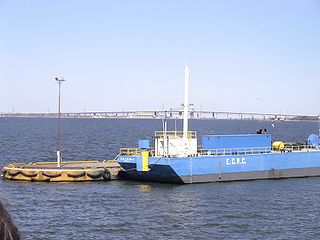
Hamilton Harbour, formerly known as Burlington Bay, lies on the western tip of Lake Ontario, bounded on the northwest by the City of Burlington, on the south by the City of Hamilton, and on the east by Hamilton Beach and Burlington Beach. It is joined to Cootes Paradise by a narrow channel formerly excavated for the Desjardins Canal. Within Hamilton itself, it is referred to as "Hamilton Harbour", "The Harbour" and "The Bay". The bay is naturally separated from Lake Ontario by a sand bar. The opening in the north end was filled in and channel cut in the middle for ships to pass. The Port of Hamilton is on the Hamilton side of the harbour.

Soil contamination, soil pollution, or land pollution as a part of land degradation is caused by the presence of xenobiotic (human-made) chemicals or other alteration in the natural soil environment. It is typically caused by industrial activity, agricultural chemicals or improper disposal of waste. The most common chemicals involved are petroleum hydrocarbons, polynuclear aromatic hydrocarbons, solvents, pesticides, lead, and other heavy metals. Contamination is correlated with the degree of industrialization and intensity of chemical substance. The concern over soil contamination stems primarily from health risks, from direct contact with the contaminated soil, vapour from the contaminants, or from secondary contamination of water supplies within and underlying the soil. Mapping of contaminated soil sites and the resulting cleanups are time-consuming and expensive tasks, and require expertise in geology, hydrology, chemistry, computer modeling, and GIS in Environmental Contamination, as well as an appreciation of the history of industrial chemistry.
Castro Creek is a creek in Richmond, California, in the western part of the city adjacent to the Chevron Oil Refinery. Wildcat Creek drains into it directly and though other Wildcat Marsh tributaries into Castro Cove of San Pablo Bay. The creek drains from the drainage basin of the surrounding area and was once part of the channel that separated the island of Point Richmond with the mainland.
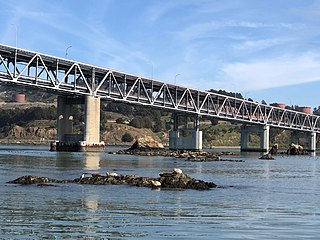
The Castro Rocks are several rocks in Richmond, California protruding from the waters in San Francisco Bay between Castro Point and Red Rock Island.The rocks lie almost directly under the Richmond-San Rafael Bridge (I-580).
Wildcat Marsh is the wetlands delta formed by the mouth of Wildcat Creek at its confluence with Castro Creek in Richmond, California. The marsh is critical habitat for endangered species and has been contaminated and damaged by runoff from the Chevron Richmond Refinery and the city's landfill and a salvage yard. The marsh was isolated from tidal effects but restoration efforts are underway as is the closure of the landfill and cleanup of the mudflats contaminated by mercury and PAHs from the refinery.
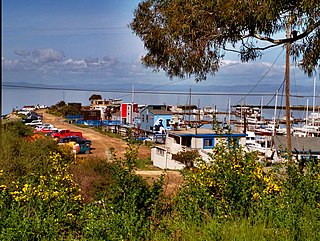
Point San Pablo Harbor is a marina and small community at the far end of Point San Pablo in San Pablo Bay, within Richmond, in Contra Costa County, California. It is located at 1900 Stenmark Drive, Richmond CA 94801.
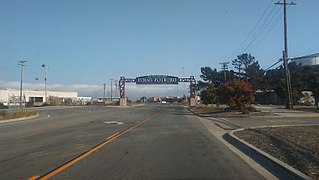
Point Potrero is a point in San Pablo Bay forming a cape and hugging the Potrero Hills in Richmond, California.
San Pablo Peninsula is a peninsula in western Richmond, between San Pablo Bay and San Rafael Bay, in southwestern Contra Costa County, California.
Stege Marsh, also known as the South Richmond Marshes, is a tidal marshland wetlands area in Richmond, California in western Contra Costa County.

The Chevron Richmond Refinery is a 2,900-acre (1,200 ha) petroleum refinery in Richmond, California, on San Francisco Bay. It is owned and operated by Chevron Corporation and employs more than 1,200 workers, making it the city's largest employer. The refinery processes approximately 240,000 barrels (38,000 m3) of crude oil a day in the manufacture of petroleum products and other chemicals. The refinery's primary products are motor gasoline, jet fuel, diesel fuel and lubricants.
The Ashland/Northern States Power Lakefront Superfund site is a contaminated region of the Wisconsin shoreline of Lake Superior that is being studied for remediation by Northern States Power Wisconsin (NSPW), as well as the Environmental Protection Agency (EPA), the Wisconsin Department of Natural Resources (WDNR). This site has held a manufactured gas plant from 1845 to 1947, as well as lumber manufacturing and treatment mills for four decades at the start of the 20th century, railcar loading facilities, and a municipal landfill. Additionally, a wastewater treatment plant is located on the premises, but is not in operation. Contamination of the site is currently believed to have been caused by all the parties mentioned above, or former owners of the property whose companies are no longer in business. The area is listed as a Superfund site by the EPA under the Comprehensive Environmental Response, Compensation, and Liability Act (CERCLA). Releases of hazardous substances occurred onshore and migrated into sediment in Chequamagon Bay on Lake Superior.

The U.S. National Oceanic and Atmospheric Administration (NOAA) National Status and Trends (NS&T) Mussel Watch Program is a water contaminant monitoring program that started in 1986. It is the longest running continuous contaminant monitoring program of its kind in the United States. Mussel Watch monitors the concentration of contaminants in bivalves and sediments in the coastal waters of the U.S., including the Great Lakes, to monitor bivalve health and by extension the health of their local and regional environment.

Between 1947 and 1977, General Electric polluted the Hudson River by discharging polychlorinated biphenyls (PCBs) causing a range of harmful effects to wildlife and people who eat fish from the river. Other kinds of pollution, including mercury contamination and cities discharging untreated sewage, have also caused problems in the river.
Equilibrium partitioning Sediment Benchmarks (ESBs) are a type of Sediment Quality Guideline (SQG) derived by the US Environmental Protection Agency (EPA) for the protection of benthic organisms. ESBs are based on the bioavailable concentration of contaminants in sediments rather than the dry-weight concentration. It has been demonstrated that sediment concentrations on a dry-weight basis often do not predict biological effects. Interstitial water concentrations, however, predict biological effects much better. This is true because the chemical present in the interstitial water is the uncomplexed/free phase of the chemical that is bioavailable and toxic to benthic organisms. Other phases of the chemical are bound to sediment particles like organic carbon (OC) or acid volatile sulfides (AVS) and are not bioavailable. Thus the interstitial water concentration is important to consider for effects to benthic organisms.
In aquatic toxicology, the sediment quality triad (SQT) approach has been used as an assessment tool to evaluate the extent of sediment degradation resulting from contaminants released due to human activity present in aquatic environments. This evaluation focuses on three main components: 1.) sediment chemistry, 2.) sediment toxicity tests using aquatic organisms, and 3.) the field effects on the benthic organisms. Often used in risk assessment, the combination of three lines of evidence can lead to a comprehensive understanding of the possible effects to the aquatic community. Although the SQT approach does not provide a cause-and-effect relationship linking concentrations of individual chemicals to adverse biological effects, it does provide an assessment of sediment quality commonly used to explain sediment characteristics quantitatively. The information provided by each portion of the SQT is unique and complementary, and the combination of these portions is necessary because no single characteristic provides comprehensive information regarding a specific site
Bog Creek Farm, located in Howell Township, New Jersey, is a designated Environmental Protection Agency (EPA) Superfund site. Laying on 12 acres of land, Bog Creek Farm is home to several hazardous and life-threatening contamination beginning in 1973 and continuing for a year. Over a decade later, actions began to take place to clean and restore the contaminated soil and water. Bog Creek Farm is situated near several other farms that house horses, growing crops and flowers, and livestock. Less than a mile down the road lies Allaire State Park, a park used by golfers, hunters, and fisherman.